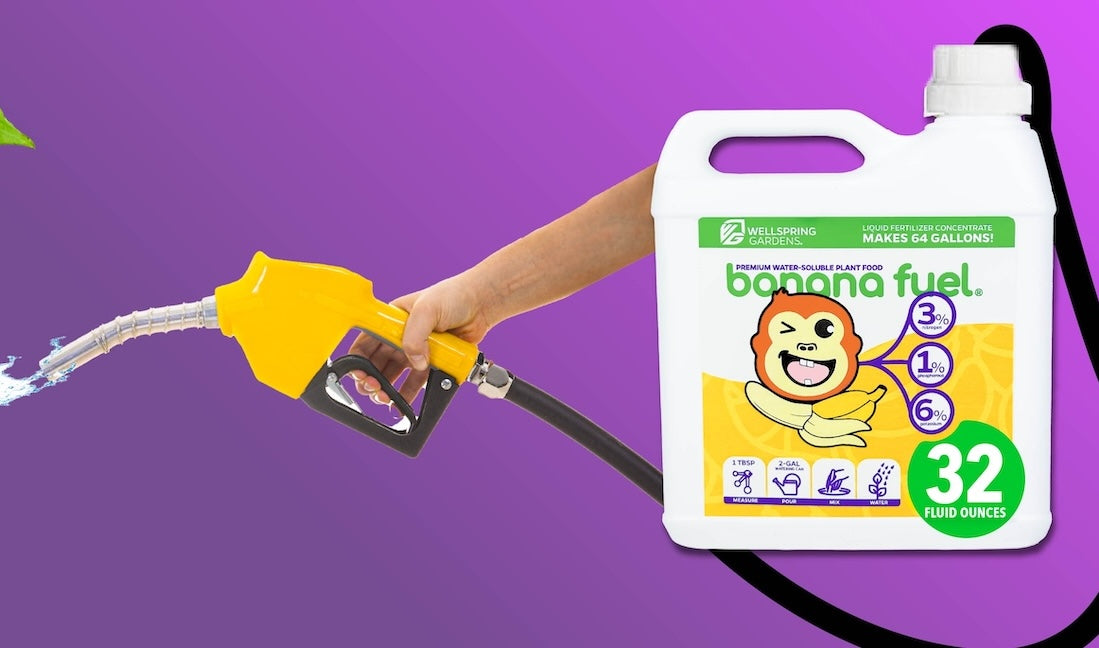Care Guide | Grapes
While most people choose grapes based solely on color (bless their hearts), true garden gurus like you choose from varying textures, tastes, purposes, and regions. Most of the grape vines we offer at Wellspring Gardens are Muscadine grapes (a.k.a., the grape of the South), but you'll also want to try our European varieties--Traminette and Blanc DuBois. Muscadines have thick skins (which is good because the skin is the most nutritious part of the grape) and a flavor that rivals even the novel Cotton Candy grape. Eat them fresh, make them into jellies, or ferment them into wines; at the end of the season, your tastebuds will surely be saying, "Y'all come back now, ya hear."
Grape culture in a nutshell
Plants have a culture they prefer, just like people from different countries and households have their own customs and traditions. To keep your plant happy, you don't have to live in a spot perfectly suited for the plant. You can give your plants the culture they crave by making a few adjustments.
Read on to learn about the culture Grapes need to thrive. If you just need a quick bullet point answer, glance at the list below. If you want more information, you can read the full deets about each point.
- 📍 Origin: Southern United States (Vitis rotundifolia), Europe (hybrids)
- 🌡️ USDA Hardiness Zones: Most are 7-11
- 📊 Classification: Deciduous perennial vines
- 📏 Height potential: 7-10 feet (most) and some up to 50-feet-tall and 30-feet wide
- 🏡 Planting location: Outdoors or indoors with the right conditions
- ☀️ Light: Full sun
- 💧 Soil/Watering: Well-drained, medium moist
- 🍴 Fertilizer: 20-6-9
- ✂️ Pruning: Early spring before coming out of dormancy and summertime
- ❄️ Cold weather care: Protect from extreme temperatures
- 🍎 Fruiting and harvesting: 2-4 years after planting
- 🕷️ Common pests: Aphids, leafhoppers, mealybugs, moths, and mites
-
🐈 Pet safe? No
The Full Deets
📍Origin
Vitis rotundifolia (Muscadine) varieties of grape are native to the Southeastern United States while most hybrids are European. While Muscadine varieties thrive in hot, humid conditions (typically zones 7-11), other types and hybrids are more cold-tolerant (often through zones 5-8). The Latin genus name, "Vitis," has the root "vit," which means life, and "vitis" which means the fruit of the vine. Just as Jesus Christ--the fruit of the vine--gives our spirits life, home-grown grapes sustain our bodies through life.
🌡️ USDA Hardiness Zones
Can I grow grapes where I live? What if I live in a cold place? No problem. If they can't grow outside in your area, repot or provide winter protection.
On each product page, we list each plant’s USDA hardiness zone. The U.S. Department of Agriculture created the hardiness map to help gardeners identify the areas in which plants tend to grow well based on past average temperatures. On the USDA's site, you can enter your zip code to identify your hardiness zone. Most grapes are only hardy in zones 7-11. If you live outside the zone, you can grow them in a pot indoors.
📊 Classification
Grapes are a vining perennial (garden lingo which means they don't die annually but rather live for many years). They are deciduous (meaning they lose all their leaves in the dormant season).
📏 Height potential
Since grapes are vining plants, they have a lot of potential for growth. Most varieties can grow anywhere from 20 to 50 feet long.
🏡 Planting location
Grape vines grow best outdoors as long as you give them as close to full sun as possible and something to climb: Plant along a fence, trellis, arbor, or pergola in full sun for best fruit production. Good air circulation and proper support structures are essential for healthy vines.
Grape arbors are a wonderful choice for growing grapes, because these canopies provide ample room for the vine to climb and create a nice canopy of shade overhead. They also make a beautiful centerpiece to any home or garden. space 6 to 8 feet apart to allow the roots and vines ample room to spread out.
If growing indoors, your vines can also produce fruit. The vine will not grow as vigorously and therefore won't have capacity to produce as many bunches of grapes, but it can fruit, and you won't have to race against the birds to enjoy your sweet fruit.
🔆 Light
Grape vines need full sun to thrive. Grape arbors provide a perfect position for soaking up those rays.
💧 Soil / Watering
Muscadines are drought-tolerant once established but benefit from regular watering during flowering and fruit development. Avoid water-logging the soil. Plant in soil that drains well and keep the soil medium moist, allowing the top 1 inch of soil to dry out slightly between waterings. This probably means you will need to water it 2-3 times per week once established, but that can also depend on your climate and pot size. Check out our watering guide to learn more about getting just the right amount of moisture for your plant.
🍴Fertilizer
For grapes, we recommend fertilizing every 7-14 days in the growing season (spring/summer). Once the cooler temperatures of fall and winter hit, you can take a break from fertilizing as your plant goes dormant.
All fertilizers contain three primary nutrients: (Nitrogen (N), Phosphorus (P), and potassium (K). Grapes thrive with a ratio of 20 Nitrogen (N), 6 phosphate (P2O5), and 9 potash (K2O) along with other micronutrients. We've got you covered with our slow-release fertilizer fuel which contains that exact balanced ratio.
✂️ Pruning
Before spring-time buds appear, prune back your grape plants to get rid of older, weaker branches. This will encourage new, healthy growth. It will also help the healthy parts of the vine to not be overcrowded so they can access full sun.
If your grape vine is unruly and you want to tidy it up, you can prune it back some in the summertime as well if desired.
❄️ Cold Weather Care
Fall sweater weather, the scent of cinnamon brooms, and the flavor of pumpkin spice emanating from the kitchen all signal the beautiful autumn leaves 🍁 we all love turning from green to a crispy orange and yellow; we know that although the leaves have fallen, the trees are still alive and well; they’re just hibernating (in plant terms, going dormant) until the spring season brings a wellspring of new life.
Compare your city’s USDA plant hardiness zone with the plant’s to see how much cold your Grape can endure 🥶. If you live outside the zone your plant is listed for, you’ll want to help it keep warm. The best way is to grow it indoors.
In the cold of fall and winter, grapes go dormant and lose all their leaves, so your plant may look like it's dead, but it's not; once the season changes, new growth will appear and pretty soon your grape will look like it never even dropped its leaves.
Learn more in our Overwintering Guide.
🍎 Fruiting and Harvesting
Since you're starting with a plant baby, fruiting time can take anywhere between 2-4 years after planting. Grapes fruit around late summer to early fall. Prepare for a feast but make sure the birds save you some fruit. Muscadine vines provide excellent food and shelter for birds and other wildlife. Their dense foliage and fruit clusters attract songbirds like cardinals, mockingbirds, and thrashers. Additionally, they support pollinators during their flowering stage. While muscadines are not butterfly host plants like passionflower vines, their ecological value still makes them ideal for naturalized or wildlife-friendly gardens.
🕷️ Common Pests
🐈 Toxic to Pets?
🤔 Troubleshooting
How should I care for my Grape after it arrives? Please give your plant a little TLC after its journey through the mail 📬. Here are a few steps we recommend:
- Unwrap immediately to provide fresh air to the plant and soil.
- Wait a few days before exposing to full sunlight so your plant can adjust after being in a dark box for several days.
- Always protect from heat and cold because temperature extremes can be stressful or deadly for plants.
- Water. Your baby plant may be parched and even a little wilted but thorough hydration will help it recover.
- Grow out in a larger pot to increase your chances of success—i.e., a quarter gallon—Then transplant to the ground or the next pot size up once the roots fill to the bottom. This will help the plant get sufficient water and nutrients directly to the roots.
Learn more in our After Arrival Care Guide.
What size pot should I use? We highly recommend growing your baby plant out in a larger pot 🪴 to increase your chances of success
You don’t have to repot immediately, but the sooner you do, the more room it has to grow.
Here are some general repotting tips:
- Start with a pot that's 1-2 inches larger in diameter than the starter-sized pot it came in. A pint or quart would be great.
- Lightly wrap sphagnum moss around the plant and place in the new pot.
- Transplant to the next pot size up once the roots fill to the bottom.
Learn more in our Repotting Guide.
Shop Grapes
Start or continue growing your Grape collection with us.
Happy planting! 🪴






